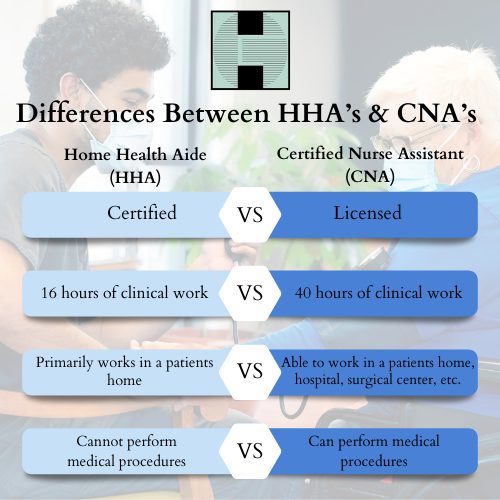
Non-Hospital Nurse Jobs
January 30, 2024
Top 10 Nursing Blogs 2024
January 31, 2024One of the biggest questions that gets asked by individuals looking to hire a care provider for a loved one is, what is the difference between Certified Nursing Assistants (CNA) and Home Health Aides (HHA)?
These two positions have many similarities. However, the differences between the two primarily lie in the places where they work, the amount of training that is required, and their responsibilities. Both HHAs and CNAs play vital roles in the healthcare system by providing essential care to patients in various settings. According to the Bureau of Labor Statistics, U.S. Department of Labor, home health and personal care aides are projected to grow 22% from 2022 – 2032. No matter the position, to become a Home Health Aide or Certified Nursing Assistant, you must possess compassion and excellent communication skills. As generations age, the demand for healthcare professionals continues to grow. If you are looking for a caretaker for a loved one, it’s important to understand the difference between these options. After reviewing this blog, you should have a better understanding of which services both offer.
What is a Home Health Aide (HHA) and Certified Nursing Assistant (CNA)?
Home Health Aide (HHA): HHAs are personal healthcare workers that help patients with basic medical issues and daily living tasks in their home setting. Typically, these patients cannot care for themselves due to a physical or mental disability. Home Health Aides help in a variety of ways with basic medical tasks. These tasks include meal preparation, grocery shopping, bathing, and other related activities. The role of an HHA plays a part in helping clients stay in their own home and stay out of any long-term care facilities.
Certified Nursing Assistant (CNA): CNAs are entry-level nursing roles that provide vital support to nurses and patients. Depending on where you reside, requirements for CNAs may differ. CNAs provide patients with basic care and support under the supervision of a licensed nurse or other medical professional. There is a wide variety of environments that they can work in such as hospitals, assisted living facilities, schools and nursing homes. Besides helping with daily living activities, they also record patient information, check vital signs, and assist with medical procedures.
HHA vs CNA Similarities
CNAs and HHAs are extremely similar in their job descriptions, duties, and other job requirements. They both offer basic healthcare such as assisting with toileting, bathing, grooming, dressing, etc. Not only do they share responsibilities, but they should also share the same qualities. Both jobs require some sort of testing to receive their license or certification. Whether being a certified nursing assistant or a home health aide, they should be detail oriented, empathetic, and have excellent communication skills.
HHA vs CNA Differences
Education and Training
While these positions share many similarities, they also have numerous differences. I’ll start off with the differences in education and training. Home Health Aides are certified whereas CNAs are licensed. To become a CNA, you must attend a state-approved CNA program at an accredited institution and pass a state licensing exam. To take the CNA exam, the individual must complete a total of 90 training hours: 50 hours of classroom work and 40 hours of hands-on clinical training. As an HHA, the federal government requires them to complete 16 hours of clinical supervised training. Generally, HHAs only need a High-school diploma or hold a GED. However, in the state of New Jersey, all Home Health Aides must be certified. Therefore, they must attend an HHA certification program. HHA programs are typically 76-hour courses and can be completed in mere weeks.
Workplace Differences
Another crucial difference is the settings in which they can work. As the HHA title suggests, they usually are placed in patients’ personal homes with remote supervision of a nurse manager. While in a home setting, they are working with one person at a time. On the other hand, CNAs have the opportunity to be a part of a healthcare team in a doctor’s office, hospital, personal homes, surgical center, long-term care facilities, schools and more. When placed in a facility setting, CNAs can work with multiple patients at once.
Responsibilities
Furthermore, there are differences in the responsibilities as well. CNAs provide slightly more advanced medical care. In certain states, CNAs can perform patient transfers, monitor vital signs, administer medications, set up medical equipment, document changes in health conditions, report to an RN or doctor and even draw blood in some states. By working under the supervision of RNs or medical doctors, this means that they can’t diagnose patients, but they can treat patients and administer care. Since HHAs are not licensed, their responsibilities are more limited than a CNA. Home Health Aides are not allowed to run certain procedures or diagnostic tests. Therefore, HHAs provide more help and supervision with daily-life activities and tasks. Whereas CNAs have the same basic responsibilities with more medical abilities.
Summary
In conclusion, one of the biggest differences between CNAs and HHAs is that CNAs can provide more help in the medical realm. HHAs are limited and can be seen more so as a companion. On the other hand, CNAs are licensed and trained more, whereas HHAs are certified and trained less. Depending on the situation of the patient, a CNA may be a better fit for those who have medical issues. An HHA may be better for those who aren’t necessarily sick or unhealthy but just struggling with old age and doing daily living tasks. With this information you should have a clear idea of which position is a better fit for your particular situation.



